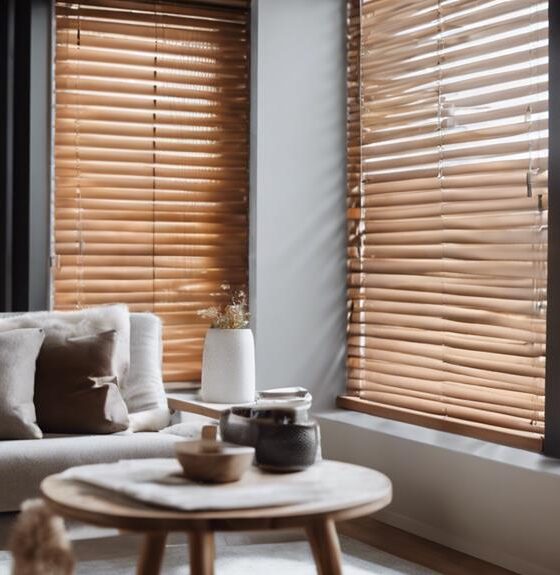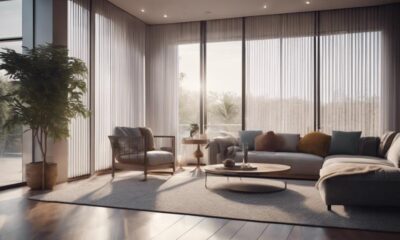Decor
DIY Navy Blue Shiplap Accent Wall: Create Your Own
From planning to execution, discover the secrets to crafting a show-stopping navy blue shiplap accent wall that elevates any room's style.
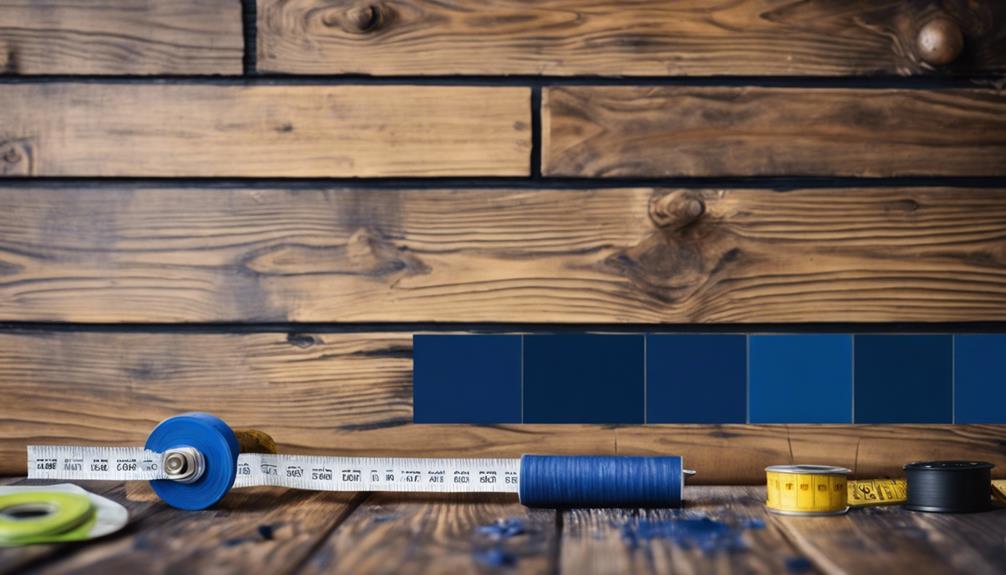
We're transforming our living spaces into stylish retreats by incorporating visually appealing accent walls, and a navy blue shiplap accent wall is a stunning way to add a pop of color and personality to any room. To create our own, we'll carefully plan the design and layout, selecting a navy blue paint color that complements the room's decor. Next, we'll measure and cut shiplap boards, applying them with finishing nails before filling gaps and sanding surfaces. With a primer and high-quality paint, we'll achieve a polished finish. Now, let's explore the intricacies of trim options, budget-friendly tips, and common mistakes to avoid, as we take our accent wall to the next level.
Key Takeaways
• Plan the design and layout of the navy blue shiplap accent wall, selecting a paint color that complements the room's decor.
• Measure the wall's dimensions and cut shiplap boards to size, staggering board lengths for a natural look.
• Fill nail holes and gaps with wood filler or caulk, and smoothly sand the surface for a polished finish.
• Prepare the shiplap surface for painting with proper cleaning, applying a primer suitable for navy blue paint color.
• Add finishing touches with trim and moulding, exploring options like white, gold, or contrasting colors to enhance the aesthetic.
Planning Your Accent Wall Design
As we start on creating a stunning navy blue shiplap accent wall, we must first carefully plan our design to guarantee an essential and visually appealing outcome. We need to take into account the dimensions of our wall and calculate the amount of shiplap needed for our project.
Next, we'll decide on the layout of our shiplap boards, choosing between a vertical or horizontal orientation for our navy blue accent wall. The spacing between the shiplap boards is also critical, as it will greatly impact the overall aesthetic of our design. We'll want to determine the best spacing to achieve the desired look for our navy blue accent wall.
Moreover, selecting a navy blue paint color that complements our room's decor and enhances the impact of our shiplap accent wall is crucial. To make sure our vision comes to life, we'll sketch or visualize our design, double-checking that the placement and pattern of the shiplap boards align with our vision for the navy blue accent wall.
Measuring and Cutting Shiplap Boards
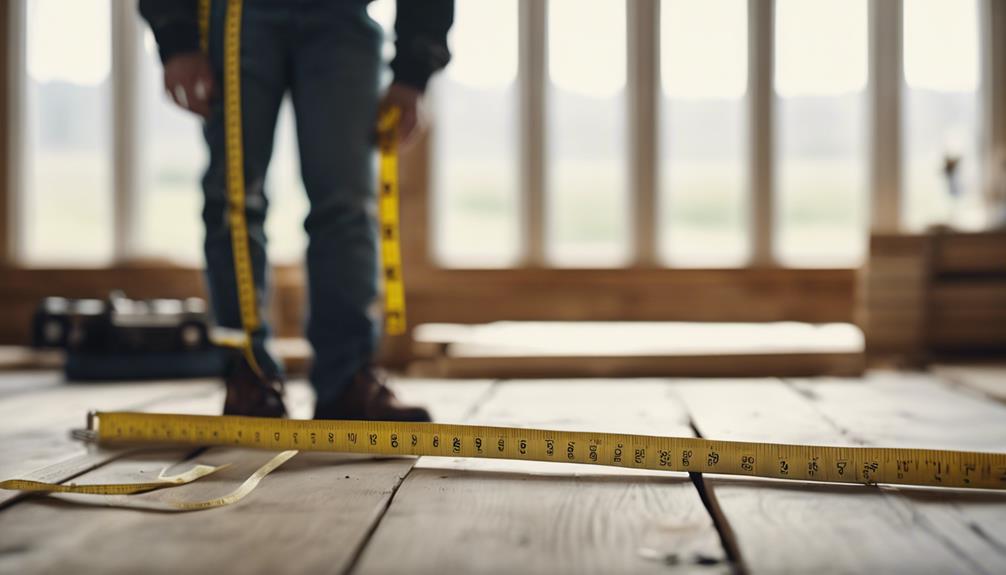
As we progress with our navy blue shiplap accent wall project, we'll need to make sure we're working with accurately measured and precisely cut shiplap boards.
To do this, we'll focus on determining the correct dimensions for our boards, taking precise measurements to avoid errors, and selecting the right cutting tools for the job.
Shiplap Board Dimensions
We measure the wall's dimensions carefully to determine how many shiplap boards we'll need to buy. This step is important in making sure we've enough material for our DIY navy blue shiplap accent wall project.
Once we've our measurements, we can start cutting our shiplap boards to the desired length using a saw. It's vital to cut the boards precisely and uniformly to achieve a professional finish.
Here are some key considerations when measuring and cutting our shiplap boards:
- Measure the length of the wall to determine how many boards we'll need
- Cut the boards to the desired length, taking into account the width of the boards (typically 6-8 inches)
- Stagger the board lengths to achieve a natural and seamless look on the accent wall
- Consider the wood grain pattern when cutting the boards to ensure a visually appealing pattern
Measuring for Accuracy
To guarantee a seamless navy blue shiplap accent wall, we measure the wall's height and width accurately to determine the number of boards needed. We use a tape measure to make sure precise measurements for each individual shiplap board. Calculating the spacing between boards is vital for a uniform and visually appealing finish. When measuring, we account for any obstacles like outlets or switches that may impact the placement of the shiplap boards.
Double-checking all measurements is essential before cutting the shiplap boards to avoid errors during installation. We take our time to ensure accurate measurements, as this step is crucial in achieving a professional-looking result.
Cutting Tools Essentials
With our precise measurements in hand, we're ready to move on to the cutting process, where the right tools and techniques make all the difference in achieving a flawless navy blue shiplap accent wall.
To guarantee accurate cuts, we'll need the right cutting tools. Here are the essentials:
- Table saw with a sharp blade: ideal for making straight cuts on shiplap boards
- Compound miter saw: perfect for angled cuts, especially for corners or edges
- Jigsaw to cut: handy for curved or irregular cuts
- Safety gear: don't forget to wear safety goggles and gloves when operating cutting tools
Before cutting, we double-check our measurements to avoid wastage and secure a seamless fit of shiplap boards.
When using a saw to cut, we make sure to use a sharp blade to prevent tear-out and splintering. By having the right tools and following proper techniques, we can achieve professional-looking results for our navy blue shiplap accent wall.
Applying Shiplap With Finishing Nails
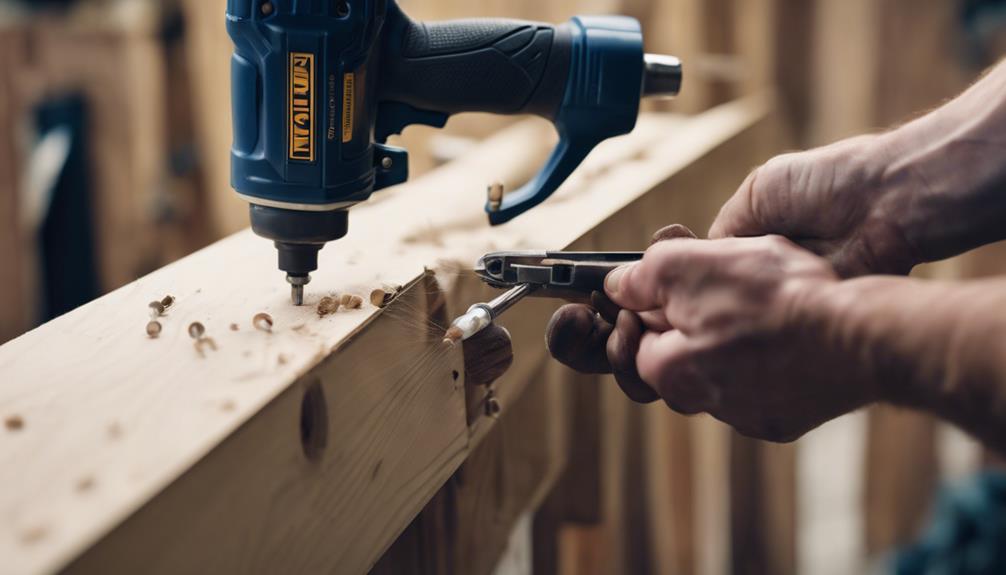
When it comes to securing shiplap boards, we opt for finishing nails, a discreet and reliable choice that guarantees a sturdy hold without leaving unsightly holes. These small, 1-2 inch nails have small heads that can be easily concealed with putty or paint, making them an ideal choice for our navy blue shiplap accent wall.
To secure a firm hold, we space the finishing nails evenly along the length of the board, taking care not to overcrowd the wall. This not only prevents the board from splitting but also allows for a professional-looking installation.
Before nailing, we pre-drill pilot holes slightly smaller than the nail diameter to prevent splitting in hardwoods or dense materials. With our finishing nails in place, we're confident that our shiplap boards will remain firmly fastened to the wall, providing a beautiful and durable accent wall that adds visual interest to any room.
Filling Gaps and Sanding Surfaces
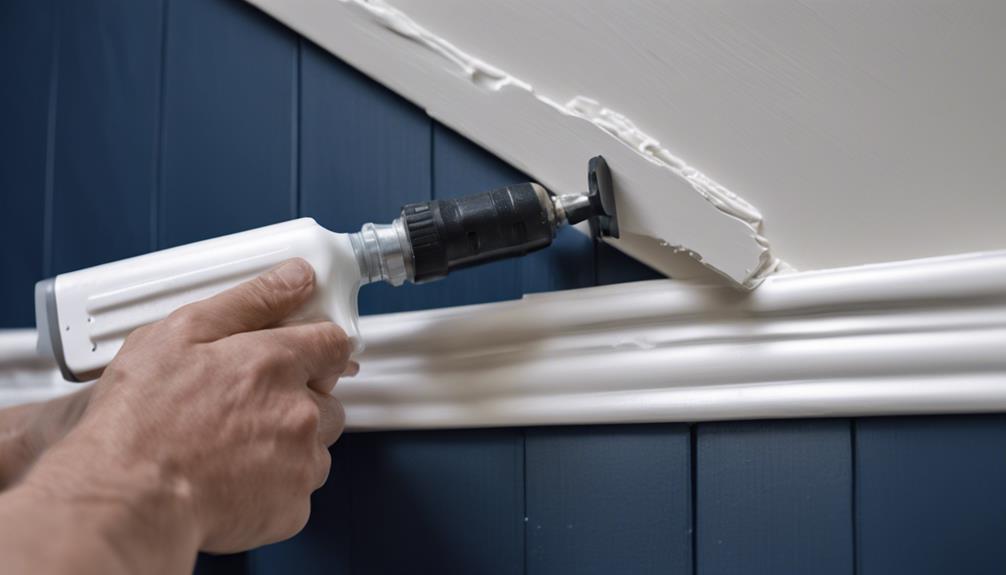
Now that we've successfully applied our shiplap with finishing nails, it's time to focus on filling gaps and sanding surfaces.
We'll need to fill nail holes completely, sand rough edges smooth, and seal gaps permanently to guarantee a seamless, professional-looking finish.
Filling Nail Holes Completely
We take the necessary step of filling nail holes completely to guarantee a flawless finish on our navy blue shiplap accent wall. This vital step ensures a seamless finish, giving our accent wall a professional look.
To achieve this, we use a high-quality wood filler to fill the nail holes, making sure to apply it generously to prevent any gaps from appearing after painting.
Here's what we keep in mind when filling nail holes completely:
- Use a high-quality wood filler to fill nail holes in the shiplap boards
- Apply the wood filler generously to prevent gaps from appearing after painting
- Smoothly sand the surface after filling the nail holes to create a seamless finish
- Pay attention to detail when filling nail holes to maintain a professional and polished look
Sanding Rough Edges Smooth
To guarantee a flawless finish on our navy blue shiplap accent wall, we tackle the task of sanding rough edges smooth, filling gaps and sanding surfaces to perfection.
Using fine-grit sandpaper, we carefully smooth out any rough surfaces and edges on the shiplap boards, removing splinters, rough patches, and imperfections for a professional look.
Sanding is essential between coats of paint to make sure a smooth and even finish on the navy blue shiplap wall. Properly sanding the surfaces also helps the paint adhere better, resulting in a more polished final appearance.
Sealing Gaps Permanently
We fill in the gaps between shiplap boards with wood filler or caulk to achieve a seamless look, guaranteeing a professional finish for our navy blue accent wall. This important step involves sealing gaps permanently to create a smooth surface, which is vital for a polished appearance.
Here's how we do it:
- Fill gaps with wood filler or caulk, selecting the appropriate product based on the size and type of gap.
- Allow the filler to dry completely to prevent uneven surfaces.
- Sand the filled gaps and surrounding surfaces with fine-grit sandpaper for a smooth finish.
- Wipe down the sanded areas to remove dust and debris before painting.
Properly sealed gaps will enhance the overall appearance and durability of the shiplap accent wall. By taking the time to fill and sand the gaps, we ensure a flawless finish that will make our navy blue accent wall stand out.
Preparing for Painting and Priming

Before transforming our accent wall into a stunning navy blue focal point, we must properly prepare the shiplap boards for painting and priming. This critical step guarantees a smooth and even finish. To achieve this, we'll sand the shiplap boards with 250 grit sandpaper to create a smooth surface, perfect for painting.
| Step | Action | Tool/ Material |
|---|---|---|
| 1 | Sand shiplap boards | 250 grit sandpaper |
| 2 | Apply primer | Sherwin-Williams Premium Wall & Wood Primer |
| 3 | Prime shiplap boards | Mini roller |
Next, we'll apply a coat of Sherwin-Williams Premium Wall & Wood Primer to the sanded boards for better paint adhesion. Using a mini roller, we'll achieve a smoother finish while priming the shiplap boards. It's crucial to ensure proper ventilation and wear protective gear during this process to create a professional-looking finish. By following these steps, we'll set ourselves up for success in the painting process, which we'll cover in the next section.
Painting With Navy Blue Perfection

Painting our shiplap accent wall a stunning navy blue requires careful attention to detail, as we're about to discover the secrets to achieving a rich, dramatic look. To get started, we'll need to choose a high-quality paint that will provide a smooth and durable finish. We recommend using Sherwin-Williams Cyberspace SW 7076 in a satin finish, which will give our DIY shiplap accent wall a sophisticated and elegant appearance.
Here are some key takeaways to keep in mind when painting with navy blue perfection:
- Use a high-quality navy blue paint in a satin finish for a smooth and durable color.
- Apply two coats of paint to achieve a rich and dramatic look, perfect for a statement wall.
- Pair navy blue shiplap with gold accents, white furniture, and natural elements for a modern and chic aesthetic.
- Contrast navy blue shiplap with light-colored decor to create a striking focal point and enhance the room's ambiance.
Adding Finishing Touches and Trim
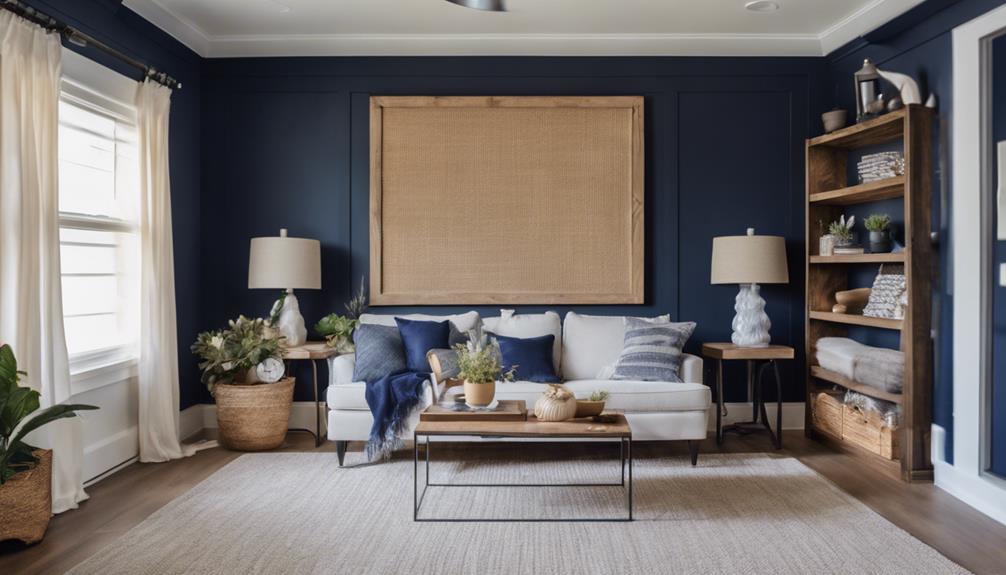
As we move forward with adding finishing touches and trim to our navy blue shiplap accent wall, we're excited to explore the various options available to enhance its overall aesthetic.
We'll examine painting trim options, moulding design ideas, and the essential finishing touches that will elevate our design. By considering these elements, we'll create a cohesive and polished look that complements our accent wall.
Painting Trim Options
With our navy blue shiplap accent wall in place, we're now focusing on adding those finishing touches, and our trim options are where we can really make a statement. The right trim can elevate the overall aesthetic of our accent wall, and we're excited to explore our possibilities.
Here are some ideas to explore:
- White trim: Provides a crisp and clean finish, enhancing the visual impact of our navy blue shiplap accent wall.
- Gold trim: Adds a touch of luxury and sophistication, creating a stylish and modern aesthetic.
- Contrasting colors: Using a trim color that contrasts with navy blue can create a visually appealing combination.
- Highlighting the structure: Adding trim to the edges of our shiplap accent wall helps define the structure and highlights the beauty of the navy blue color.
Moulding Design Ideas
We're taking our navy blue shiplap accent wall to the next level by incorporating moulding design ideas that add a touch of sophistication and elegance to our space. To achieve this, we're considering various moulding profiles and sizes to find the perfect combination for our accent wall.
Picture frame moulding, for instance, can create a classic and elegant look, while crown moulding can add a touch of sophistication and visual interest. We're also experimenting with chair rail moulding to create a defined separation between the navy blue shiplap and the wall above, enhancing the overall aesthetic.
Additionally, baseboard moulding can provide a finished look to the bottom of our accent wall, tying the design together seamlessly. By incorporating these moulding design ideas, we can elevate our navy blue shiplap accent wall from a simple DIY project to a stunning focal point in our room.
With a little creativity and experimentation, we can create a unique and stylish design that reflects our personal taste and style.
Finishing Touches Essentials
Our navy blue shiplap accent wall's transformation is nearly complete, and it's time to focus on the finishing touches that will elevate it from a DIY project to a stunning design element. Adding those final flourishes can make all the difference in creating a polished, professional look.
To take our shiplap wall to the next level, we're going to focus on adding trim and other finishing touches. Here are some essentials to ponder:
- Trim: Choose trim that complements the navy blue color of your shiplap wall for a cohesive look.
- Edge finishing: Use trim to create a clean, polished edge where the shiplap meets other surfaces.
- Corner details: Add trim to corners to create a seamless shift and enhance the overall aesthetic.
- Depth and dimension: Incorporate trim to add depth, dimension, and visual interest to your DIY navy blue shiplap accent wall.
Budget-Friendly Tips and Tricks

We can achieve a stylish navy blue shiplap accent wall without draining our bank account by incorporating a few budget-friendly tips and tricks into our design plan.
For instance, we can utilize affordable materials like luan or thin plywood for our DIY shiplap project, which will greatly reduce costs. By opting for DIY shiplap installation, we can save on labor costs while still achieving a stylish look.
Additionally, sanding the materials before painting guarantees a smooth finish without splinters, which is a crucial step in creating a beautiful accent wall. To add a pop of color, we can choose a rich navy blue paint color that makes a bold and elegant statement without breaking the bank.
Common Mistakes to Avoid
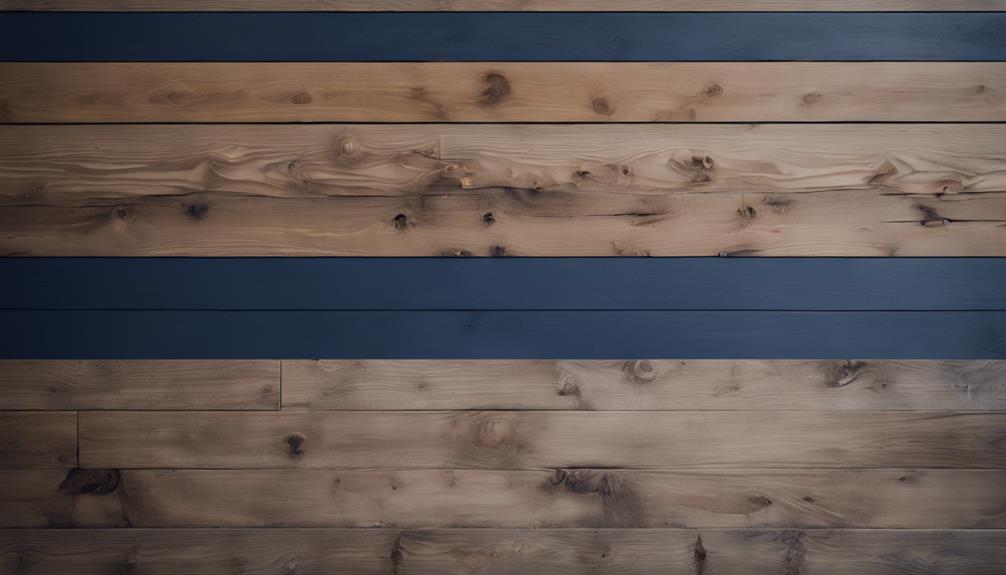
When tackling a navy blue shiplap accent wall project, it's important to sidestep common mistakes that can quickly derail your design vision and leave you with a lackluster result. We've learned that avoiding these mistakes is key to achieving a professional-looking finish.
Here are some common mistakes to avoid:
- Inconsistent spacing: Make sure to maintain an equal gap between boards for a polished look. Avoid spacing boards too closely together, as this can create a cluttered appearance.
- Uneven cuts and measurements: Take your time to guarantee precise cuts and measurements. We've used a jigsaw to get accurate cuts, and it's made a huge difference.
- Neglecting prep work: Don't skip priming and sanding before painting. This step is essential for a smooth, even finish that will withstand wear and tear.
- Incorrect installation: Take your time to ensure each board is securely attached and level. Using the wrong type of nails or adhesive can compromise the durability of your real shiplap wall.
Final Reveal and Styling Tips
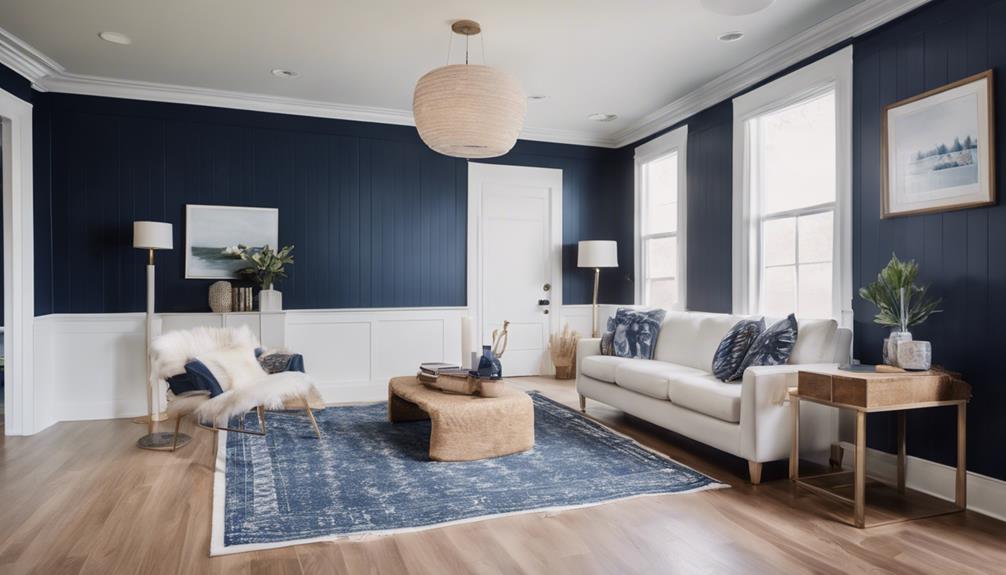
With the navy blue shiplap accent wall complete, it's time to style it with intention and flair to create a cohesive, show-stopping look. As we step back to admire our handiwork, we're excited to share our final reveal and styling tips to take this bold and sophisticated feature wall to the next level.
To create a balanced contrast, we'll pair our navy blue shiplap wall with neutral furniture, allowing the bold hue to take center stage.
We'll add a touch of elegance with gold accents, such as frames, mirrors, or decor pieces, which will beautifully complement the deep navy blue hue.
To add visual interest, we'll incorporate pops of color through throw pillows, rugs, or artwork, carefully selecting shades that harmonize with the navy blue.
Finally, we'll bring warmth and texture to the space by incorporating natural elements like greenery or wooden decor.
Frequently Asked Questions
How to DIY Shiplap Accent Wall?
When deciding how to DIY a shiplap accent wall, we first measure and cut the boards to fit our wall dimensions.
Next, we start from the top and work our way down, using a level to guarantee straight alignment and spacing between each board.
We fill nail holes with putty, sand smooth, and prime the wall before painting.
Is It Cheaper to Make Your Own Shiplap?
We've wondered, is it cheaper to make our own shiplap?
The answer is yes. By creating our own shiplap, we can greatly reduce expenses.
We can opt for cost-effective materials like luan or plywood, which are more budget-friendly than pre-made shiplap boards.
This DIY approach allows us to control costs and quality, making it a more economical option.
What Is the New Trend Instead of Shiplap?
We've noticed a shift away from traditional shiplap towards more unique and visually appealing alternatives. Vertical or herringbone wood patterns are gaining popularity, while board and batten offers a classic yet modern twist.
Chevron and diagonal wood installations are also on the rise, providing a bold statement. Additionally, tongue and groove paneling and reclaimed wood accent walls offer refined and rustic options, respectively, for those looking to deviate from traditional shiplap designs.
Is Shiplap Still in Style in 2024?
As we explore the current design landscape, we find that shiplap remains a staple in 2024. Its timeless appeal and versatility have solidified its place in modern and traditional homes alike.
Despite the emergence of new trends, shiplap's textured charm and ability to add depth and character to spaces continue to make it a sought-after design choice.
Conclusion
As we step back to admire our handiwork, our navy blue shiplap accent wall stands proudly, like a masterpiece in a gallery.
With every detail meticulously planned and executed, our DIY project has transformed a once-bland space into a stunning focal point.
With a few simple tools and some elbow grease, we've created a show-stopping feature that's sure to impress.
And the best part? We did it ourselves, on a budget, and with style.
- About the Author
- Latest Posts
Introducing Ron, the home decor aficionado at ByRetreat, whose passion for creating beautiful and inviting spaces is at the heart of his work. With his deep knowledge of home decor and his innate sense of style, Ron brings a wealth of expertise and a keen eye for detail to the ByRetreat team.
Ron’s love for home decor goes beyond aesthetics; he understands that our surroundings play a significant role in our overall well-being and productivity. With this in mind, Ron is dedicated to transforming remote workspaces into havens of comfort, functionality, and beauty.
Alfresco
Is It Al Fresco or Alfresco? Proper Usage Explained!
Fascinated by the distinctions between 'al fresco' and 'alfresco'? Unravel the proper usage nuances and delve into the cultural significance behind these terms.
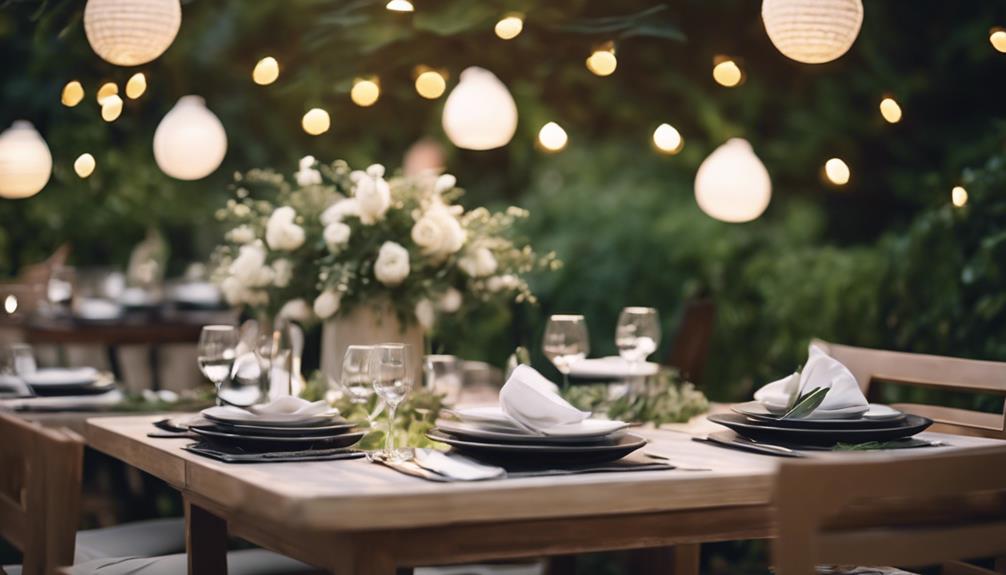
When deciding between 'al fresco' and 'alfresco,' it's important to grasp their nuanced disparities for accurate usage. 'Al fresco,' originating from Italian, pertains specifically to outdoor dining. In contrast, 'alfresco' in English signifies a broader scope of outdoor activities. The evolution of these terms displays a deep connection to embracing nature and fresh air. Synonymous terms like open-air, outdoor, and outdoorsy elevate descriptions of outdoor experiences. Recent trends expand alfresco dining to unique settings like rooftops, appealing to a growing audience. Understanding these distinctions enhances communication and cultural awareness, adding depth to descriptions.
Key Takeaways
- Consider context: 'Al fresco' for dining outdoors, 'alfresco' for general outdoor activities.
- Understand origins: 'Al fresco' from Italian meaning 'in the cool air.'
- Use interchangeably: Both terms accepted in English for outdoor experiences.
- Different meanings: 'Al fresco' for dining, 'alfresco' for broader outdoor events.
- Ensure clarity: Proper usage reflects context and Italian vs. English distinctions.
Origins and Meaning of 'Al Fresco'
When exploring the origins and meaning of 'Al Fresco,' it's essential to understand its Italian roots and its association with outdoor settings.
The term 'al fresco' originates from Italian, translating to 'in the cool air.' It's commonly used to describe dining or events that take place in the open air. Curiously, while Webster's dictionary defines it as located outdoors, Italians also use it to refer to time spent in jail. The term 'alfresco' is often used interchangeably with 'al fresco' in English, although Italians don't commonly use it for outdoor dining.
'Al Fresco' has gained popularity in English-speaking countries for describing open-air activities. It has become synonymous with enjoying meals or gatherings outside, capturing the essence of nature and fresh air.
This term evokes a sense of freedom and relaxation, making it a popular choice for describing outdoor experiences in various contexts.
Usage Differences Between Italian and English
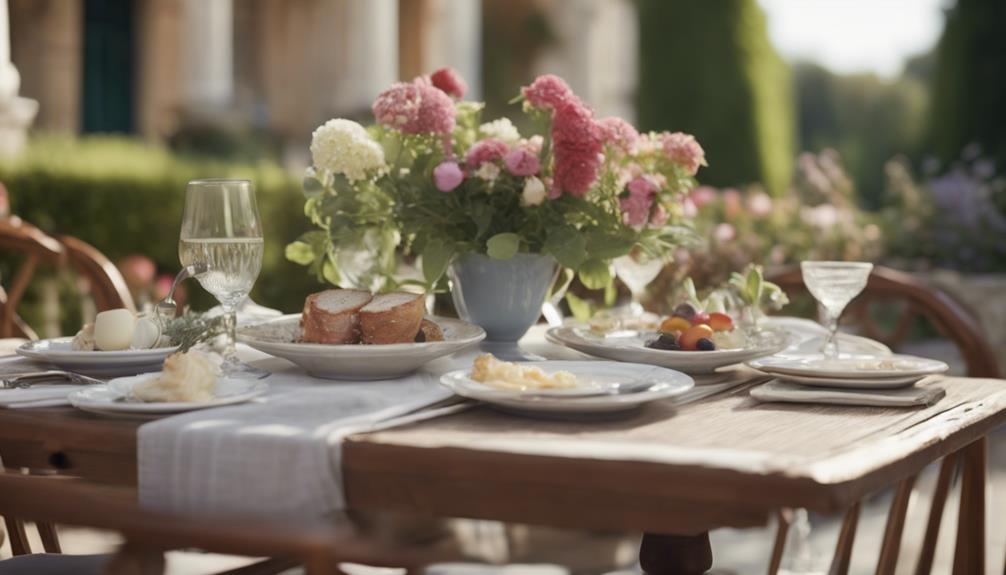
In Italian, the spelling variation 'al fresco' is used to denote imprisonment, contrasting with the English term 'alfresco' that signifies outdoor activities.
The discrepancies in spelling and pronunciation between the two languages can lead to confusion in understanding the intended meaning.
Recognizing these distinctions is essential to accurately convey the context when using 'al fresco' or 'alfresco' in Italian or English settings.
Italian Spelling Variations
The distinction between the Italian spelling 'al fresco' and the English term 'alfresco' lies in their nuanced usage differences regarding outdoor activities and settings. In Italian, 'al fresco' typically refers to time spent in jail, while in English, 'alfresco' describes outdoor dining or leisure activities. To clarify these differences further, let's explore them in a table below:
| Aspect | Al Fresco (Italian) | Alfresco (English) |
|---|---|---|
| Common Usage | Less frequently used for outdoor events | Commonly used for outdoor dining and activities |
| Emphasis | Cool air or outdoors | Open-air settings for dining or events |
| Context | More likely in Italian contexts | Preferred spelling in English for outdoor experiences |
| Specific Meaning | Refers to being outdoors in the fresh air | Signifies outdoor events or dining experiences |
| Usage Variance | Primarily Italian context | Widely used in English for outdoor settings |
Understanding these distinctions can help in appropriately using 'al fresco' or 'alfresco' in the right context.
English Pronunciation Discrepancy
Let's highlight the pronunciation discrepancy between the Italian term 'al fresco' and the English term 'alfresco' to better understand their distinct usage differences.
In Italian, 'al fresco' is pronounced 'ahl FRES-koh' and translates to 'in the cool air'. Surprisingly, in Italian, this term is commonly used to refer to time spent in jail, portraying a stark contrast to its English meaning.
On the other hand, 'alfresco' in English is pronounced 'ahl-FRES-koh' and is more frequently used to describe outdoor dining or events, emphasizing the idea of being open to the fresh air.
While the terms share a similar essence, 'al fresco' holds a more specific connotation in Italian related to confinement, unlike its broader application in English to denote activities conducted in the open.
Recognizing this pronunciation and usage variance between the two languages sheds light on the subtle differences in how 'al fresco' and 'alfresco' are employed, ensuring effective communication in English contexts.
Evolution of the Term in English
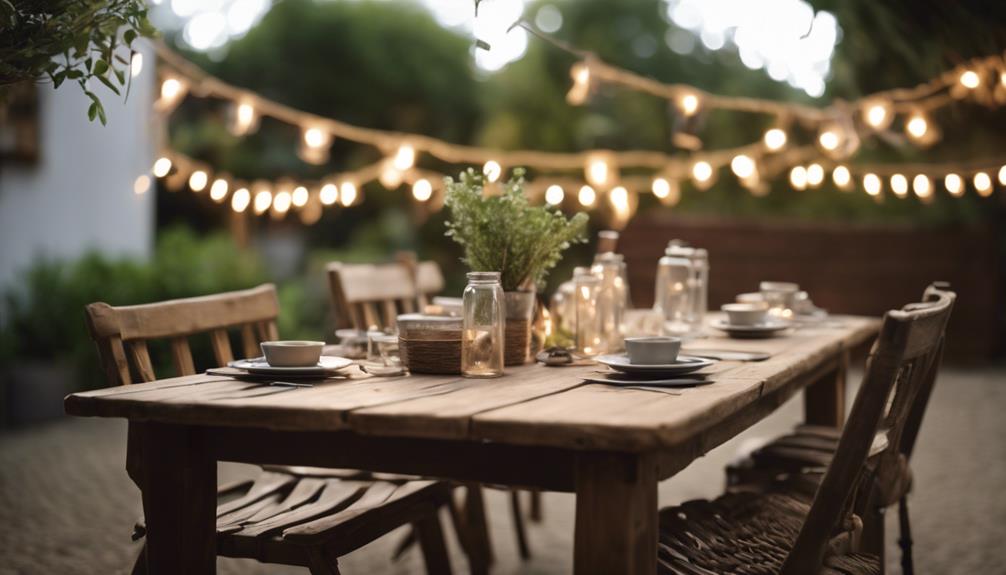
Through centuries of linguistic adaptation, 'alfresco' has seamlessly integrated into the English lexicon, embodying a sense of outdoor energy and connection to the natural world. Originating from Italian, where it means 'in the cool air,' the term 'alfresco' in English typically describes events or activities located in the open air.
This term is commonly associated with outdoor dining, cafes, performances, and even a style of painting. The evolution of 'alfresco' in English showcases a deep-rooted connection to nature and the enjoyment of fresh air in various outdoor settings.
While 'alfresco' is the more prevalent spelling in English, 'al fresco' is also frequently used interchangeably. This adaptive nature of the term reflects its versatility and broad application across different contexts.
Whether used to depict a delightful meal under the stars or an artistic creation inspired by the outdoors, 'alfresco' continues to serve as a symbol of embracing the beauty and significance of the natural world in the English language.
Common Synonyms for 'Al Fresco'
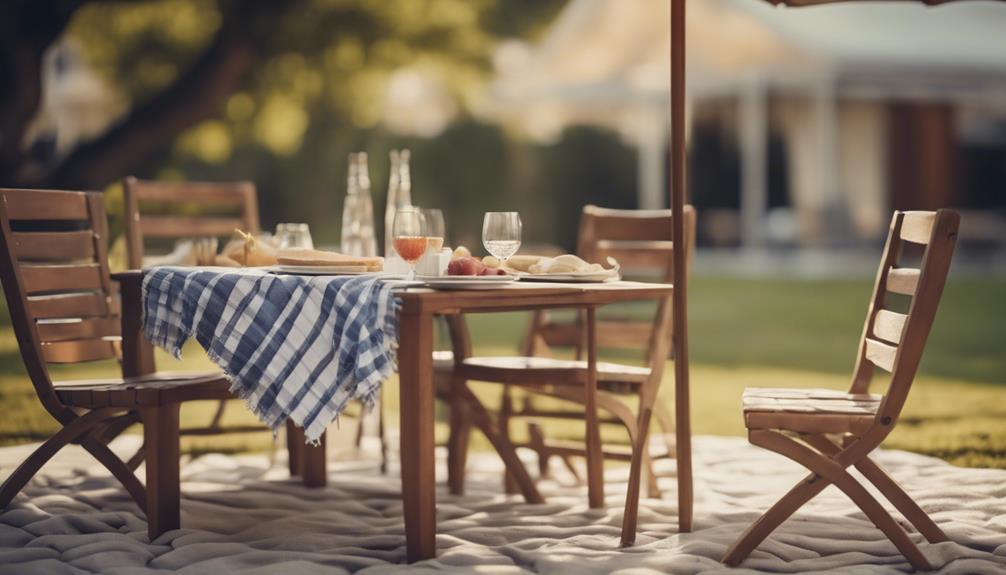
Common synonyms for enjoying a meal or activity outdoors, such as 'al fresco,' include open-air, outdoor, and outdoorsy. These terms are often used interchangeably with 'al fresco' or 'alfresco' when referring to outdoor dining or events. Originating from Italian, both 'al fresco' and 'alfresco' signify activities conducted in the open air.
Adding a touch of elegance and sophistication, the use of these synonyms can elevate the description of outdoor experiences. Whether dining under the stars or having a picnic in the park, the terms open-air, outdoor, and outdoorsy encapsulate the essence of enjoying nature while engaging in various activities.
When planning a gathering or simply wanting to savor a meal outside, opting for one of these synonyms can convey a sense of appreciation for the surroundings. Understanding the nuances among these terms can enhance communication and cultural awareness, enriching the outdoor dining experience for all involved.
Modern Applications of 'Al Fresco'
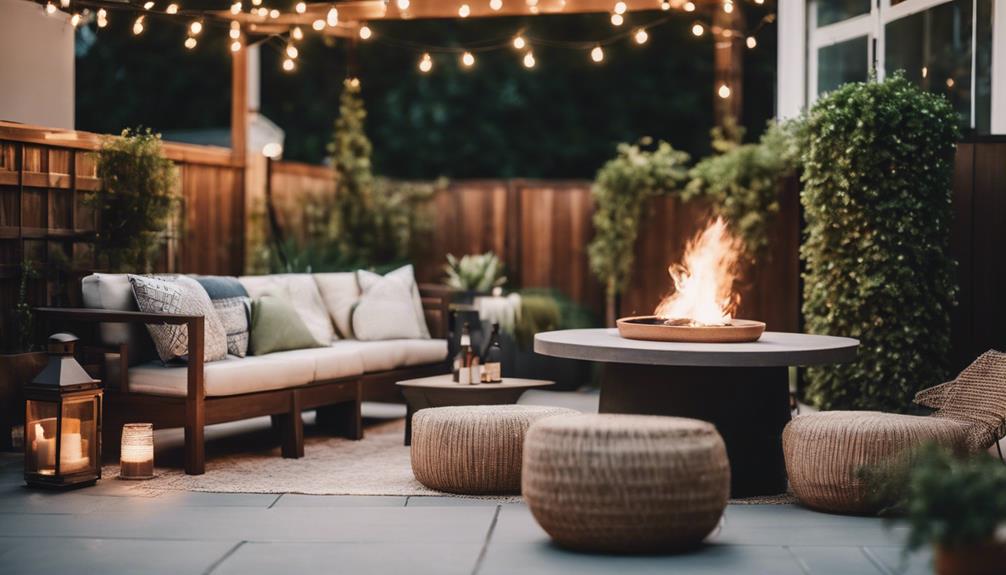
Alfresco dining has evolved beyond traditional settings. Modern trends embrace outdoor dining in urban areas. Rooftop gatherings and pop-up dining experiences are becoming increasingly popular. People seek unique al fresco dining experiences.
This shift reflects a growing appreciation for dining under the open sky amidst bustling cityscapes.
Outdoor Dining Trends
Exploring the modern applications of 'al fresco' dining reveals a variety of outdoor dining trends that have captivated diners worldwide. The term 'al fresco' is often used to describe dining experiences that take place or are located outdoors, such as in rooftop bars, sidewalk cafes, and garden settings. This trend has gained popularity due to its appeal in social settings, offering patrons the chance to enjoy fresh air while indulging in delicious meals. 'Al fresco' dining has become a sought-after option for those looking to create memorable experiences and savor their meals in unique environments.
The rise of outdoor dining trends has led to an increase in alfresco dining options in urban areas, parks, and scenic locations. This shift towards embracing outdoor spaces for dining has transformed the restaurant industry, with more establishments incorporating open-air seating arrangements to cater to the growing demand for al fresco experiences. From casual picnics to upscale garden dining, the allure of dining outdoors continues to shape the way people enjoy their meals.
Urban Rooftop Gatherings
The modern urban landscape embraces the allure of 'al fresco' dining through vibrant and trendy urban rooftop gatherings. These unique events offer a blend of city views and outdoor ambiance, creating a trendy and vibrant atmosphere in metropolitan areas.
Rooftop venues host various activities, from rooftop bars and restaurants to yoga sessions and live music performances, fully embracing the 'al fresco' trend.
Urban rooftop gatherings provide a sophisticated and novel way to enjoy the outdoors in a city environment. The versatility of these events caters to a wide range of occasions, from casual hangouts to special celebrations and networking events.
Attendees can revel in the bustling cityscape while experiencing the fresh air and open spaces that rooftop gatherings offer. The combination of urban amenities and outdoor elements adds a touch of excitement and exclusivity to social experiences in modern urban landscapes.
Tips for Proper Usage of 'Al Fresco
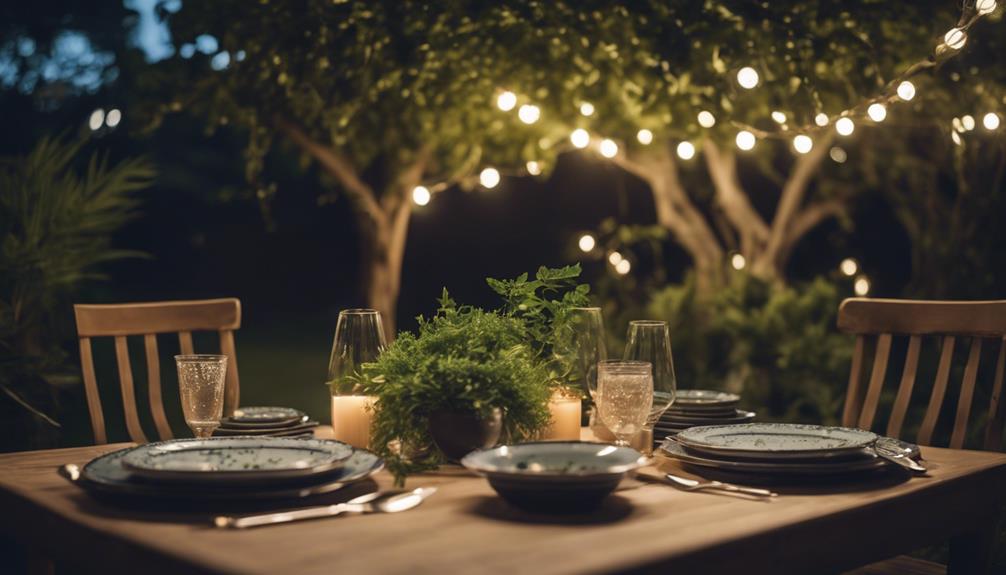
For those seeking clarity on when to use 'al fresco' or 'alfresco', consider the context and personal preference as guiding factors. When it comes to dining outdoors, the term 'al fresco' is traditionally Italian and specifically denotes eating outside.
In English, 'al fresco' is more commonly associated with outdoor dining experiences, while 'alfresco' is often used more broadly to describe any outdoor events or activities. Both terms, however, can be used interchangeably in English language contexts.
To guarantee proper usage of 'al fresco' in the context of eating outside, it's recommended to stick with this traditional Italian term. If you're discussing a delightful outdoor dining experience, using 'al fresco' would be the more suitable choice.
Frequently Asked Questions
Is It Alfresco or Al Fresco?
It's a common query on whether to use "alfresco" or "al fresco." We prefer "alfresco" as it's the correct spelling in English. The nuances in language are important for clear communication and proficiency.
How Do You Use the Word Alfresco?
When using the word "alfresco," we prefer to dine outside, enjoying nature's beauty. It's an Italian term that perfectly captures the essence of outdoor gatherings. Let's savor the fresh air together!
Is Eating Outside Called Al Fresco?
Eating outside is indeed called al fresco. It's a delightful experience that we love, connecting us to nature and adding a special touch to our meals. The term 'al fresco' originates from Italian, meaning 'in the cool air.'
Do Italians Say "Al Fresco"?
Italians do not commonly say 'al fresco' for outdoor dining. The correct term in English is 'alfresco.' Understanding the difference can help in proper usage. We've learned to use 'alfresco' for outdoor dining.
Conclusion
To sum up, whether you prefer to dine al fresco or alfresco, the meaning remains the same. Both terms refer to enjoying a meal or activity in the open air.
So, next time you're planning a picnic or outdoor event, remember to use this term correctly. Just like a delicious meal enjoyed outdoors, proper language usage adds a touch of sophistication to any occasion.
So, embrace the al fresco experience and savor every moment!
- About the Author
- Latest Posts
Introducing Ron, the home decor aficionado at ByRetreat, whose passion for creating beautiful and inviting spaces is at the heart of his work. With his deep knowledge of home decor and his innate sense of style, Ron brings a wealth of expertise and a keen eye for detail to the ByRetreat team.
Ron’s love for home decor goes beyond aesthetics; he understands that our surroundings play a significant role in our overall well-being and productivity. With this in mind, Ron is dedicated to transforming remote workspaces into havens of comfort, functionality, and beauty.
Alfresco
Is Frenchic Alfresco Waterproof? Discover the Benefits!
Curious if Frenchic Alfresco paint is waterproof? Explore its protective benefits for outdoor surfaces and unleash its durability and elegance!

Frenchic Alfresco paint is indeed waterproof, safeguarding outdoor surfaces effectively. This paint offers exceptional durability and UV resistance, ensuring protection against extreme weather conditions. Its smooth finish adds a touch of elegance to outdoor projects, and the eco-friendly composition is an added bonus. Specifically designed to withstand the elements, Frenchic Alfresco forms a waterproof coating, preventing chipping or flaking. By choosing this paint, you can confidently enhance and protect your outdoor surfaces with a long-lasting solution. With Frenchic Alfresco, your outdoor projects are set to withstand the test of time and various weather challenges.
Key Takeaways
- Specially formulated for weatherproofing with waterproof coating.
- Resists UV exposure and extreme weather conditions.
- Prevents chipping or flaking for exceptional durability.
- Excellent adhesion properties ensure longevity.
- Eco-friendly composition with smooth velvety finish.
Key Features of Frenchic Alfresco Paint
Let's explore the standout features of Frenchic Alfresco paint. This durable paint isn't only weatherproof but also offers UV resistance, making it perfect for outdoor use. Its self-priming and self-sealing properties guarantee excellent coverage and protection against the elements.
Frenchic Alfresco paint boasts a flat finish that gives outdoor furniture, fences, and garden decor a fresh look. Additionally, with minimal VOC content, it's safe for both indoor and outdoor applications, meeting UKCA and EN71-3 compliance standards.
The paint's long-lasting formula makes it a reliable choice for various surfaces, while its waterproof nature adds an extra layer of protection. Whether you're looking to spruce up your garden furniture or add a pop of color to your outdoor space, Frenchic Alfresco paint is a versatile option that combines durability with a sleek finish.
Weatherproof Properties of Frenchic Alfresco

Frenchic Alfresco paint's renowned weatherproof properties make it an excellent choice for outdoor projects, ensuring longevity and durability in various weather conditions.
The Frenchic Al Fresco range is specially formulated to be weatherproof, making it an ideal option for outdoor use. This paint is designed to resist UV exposure and extreme weather conditions, protecting surfaces from fading and deterioration over time.
One of its standout features is its exceptional adhesion, which helps prevent chipping or flaking, ensuring that painted surfaces maintain a fresh appearance for years to come.
Whether you're painting fences, garden furniture, or sheds, Frenchic Al Fresco offers a durable solution that can withstand the elements. Its ability to weatherproof painted surfaces effectively makes it a reliable choice for outdoor projects where longevity and resilience are essential.
Frenchic Al Fresco is a top contender when it comes to ensuring your outdoor spaces look great for the long haul.
Benefits of Using Frenchic Alfresco Paint
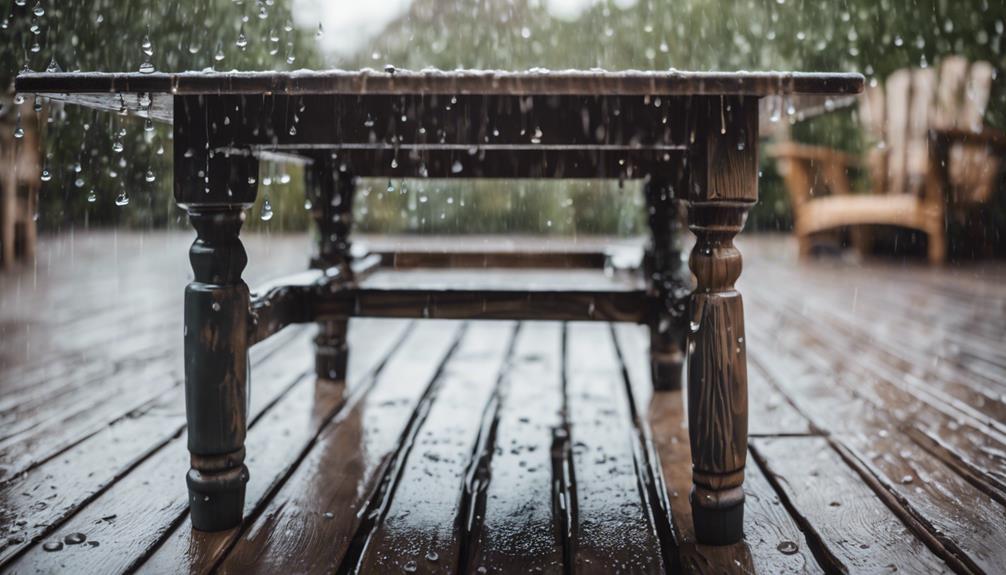
When considering the benefits of using Frenchic Al Fresco paint, it's important to highlight its exceptional durability and weatherproof properties. Frenchic Al Fresco paint isn't only waterproof but also UV resistant, making it an ideal choice for both indoor and outdoor projects.
Its ability to withstand various weather conditions guarantees longevity and protection for your surfaces. Additionally, this paint offers a smooth and velvety finish, adding a touch of elegance to any project.
What sets Frenchic Al Fresco apart is its eco-friendly composition, being water-based and virtually odourless. Furthermore, its self-priming and self-sealing features make application effortless and efficient, providing excellent coverage with minimal hassle.
With a wide array of colors and limited edition options available, Frenchic Al Fresco paint proves to be a versatile and reliable choice for all your painting needs.
Durability and Longevity of Frenchic Alfresco

Discussing the durability and longevity of Frenchic Alfresco paint reveals its remarkable ability to guarantee various weather conditions and provide lasting protection for surfaces. This water-based paint is specifically designed to be durable and weatherproof, making it an excellent choice for outdoor use.
Its exceptional adhesion properties guarantee a long-lasting finish on different surfaces, enhancing its reliability for outdoor projects. Additionally, the UV resistance of Frenchic Alfresco paint allows it to maintain its color and quality even when exposed to direct sunlight, further contributing to its longevity.
When applied correctly and allowed to cure properly, this paint forms a waterproof coating that offers reliable protection against the elements. Overall, the combination of being water-based, durable, weatherproof, and offering excellent adhesion properties and UV resistance makes Frenchic Alfresco a trusted and long-lasting option for outdoor painting projects.
Application Tips for Frenchic Alfresco

For optimal results when using Frenchic Alfresco paint, it's essential to follow specific application tips to guarantee a successful outcome. This waterproof outdoor paint is known for its durability and weather resistance, making it ideal for various surfaces like outdoor furniture and fences.
To assure a flawless application, start by preparing the surface thoroughly. Use high-quality brushes or rollers to apply thin coats evenly. Frenchic Alfresco paint is self-priming, simplifying the process and enhancing adhesion to the surface. Its eco-friendly formulation with minimal VOC content adds to its appeal for environmentally-conscious users.
Frequently Asked Questions
Is Frenchic Alfresco Paint Waterproof?
Yes, Frenchic Al Fresco paint is waterproof. It is ideal for outdoor surfaces like garden furniture, fences, and sheds. With excellent adhesion properties and UV resistance, it maintains color and quality while providing durability for both interior and exterior projects.
Does Frenchic Alfresco Need a Finishing Coat?
We love that Frenchic Al Fresco doesn't need a finishing coat! Its self-sealing and self-levelling properties make it a breeze to use. With excellent coverage and durability, this paint simplifies the process and delivers a waterproof finish.
How Long Does It Take for Frenchic Alfresco to Cure?
It typically takes Frenchic Al Fresco 2-3 weeks to fully cure, allowing the paint to harden and become durable. The curing process guarantees maximum strength and resistance to wear and tear, making the surface waterproof and weather-resistant.
What Is so Special About Frenchic Paint?
Frenchic paint stands out for its water-based formula, durability, and versatility. It's self-priming and seals effortlessly. With UV resistance, low VOCs, and a range of vibrant colors, it's a top choice for eco-friendly, odorless projects.
Conclusion
To sum up, Frenchic Alfresco paint offers a range of benefits, including weatherproof properties and long-lasting durability. Its application is simple and straightforward, making it a great choice for outdoor projects.
With Frenchic Alfresco, you can trust that your surfaces will be protected and looking great for years to come. So why settle for anything less? Choose Frenchic Alfresco for a reliable and stylish finish that will stand the test of time.
- About the Author
- Latest Posts
Introducing Ron, the home decor aficionado at ByRetreat, whose passion for creating beautiful and inviting spaces is at the heart of his work. With his deep knowledge of home decor and his innate sense of style, Ron brings a wealth of expertise and a keen eye for detail to the ByRetreat team.
Ron’s love for home decor goes beyond aesthetics; he understands that our surroundings play a significant role in our overall well-being and productivity. With this in mind, Ron is dedicated to transforming remote workspaces into havens of comfort, functionality, and beauty.
Alfresco
Is an Alfresco a Verandah? Know the Difference!
Discover the key distinction between an alfresco and a verandah, essential for creating the perfect outdoor living space.

In the world of outdoor living spaces, an alfresco is distinct from a verandah. An alfresco is a modern outdoor area with kitchens and dining spaces, offering a contemporary touch. Conversely, a verandah is a covered structure extending from a house, providing traditional charm and weather protection. While both connect indoor and outdoor spaces, the alfresco exudes modern sophistication, contrasting the verandah's timeless appeal. Understanding these differences can help in choosing the right fit for your home.
Key Takeaways
- Alfrescos are modern outdoor living spaces with kitchen and dining areas, while verandahs are covered structures extending from the house.
- Alfrescos offer contemporary outdoor entertainment, while verandahs provide traditional charm and weather protection.
- Alfrescos have open layouts for year-round use, whereas verandahs can be enclosed or have open sides for bug protection.
- Alfrescos focus on seamless indoor-outdoor transitions, while verandahs offer a cozy enclosed feeling.
- Alfrescos are at ground level for easy access, while verandahs are elevated structures attached to the house, often requiring stairs for entry.
Alfresco Vs Verandah Overview
Let's compare alfrescos and verandahs to understand their distinct features and functions.
Alfrescos are modern outdoor living spaces often equipped with outdoor kitchens and dining areas, perfect for entertaining guests. They offer a versatile patio for year-round use, complete with walls, privacy screens, and outdoor furniture.
In contrast, verandahs are covered structures extending from a house, providing a charming seating area with weather protection, adding character and charm to the home's exterior. Verandahs may have open sides or be screened in for bug protection, offering a traditional and classic appeal.
Both alfrescos and verandahs create a seamless connection between indoor and outdoor spaces. While alfrescos are associated with contemporary outdoor living, verandahs are known for their timeless elegance and cozy atmosphere.
When choosing between an alfresco and a verandah, consider your outdoor living needs and the style you wish to achieve for your home's exterior space.
Structural Differences Between Alfresco and Verandah
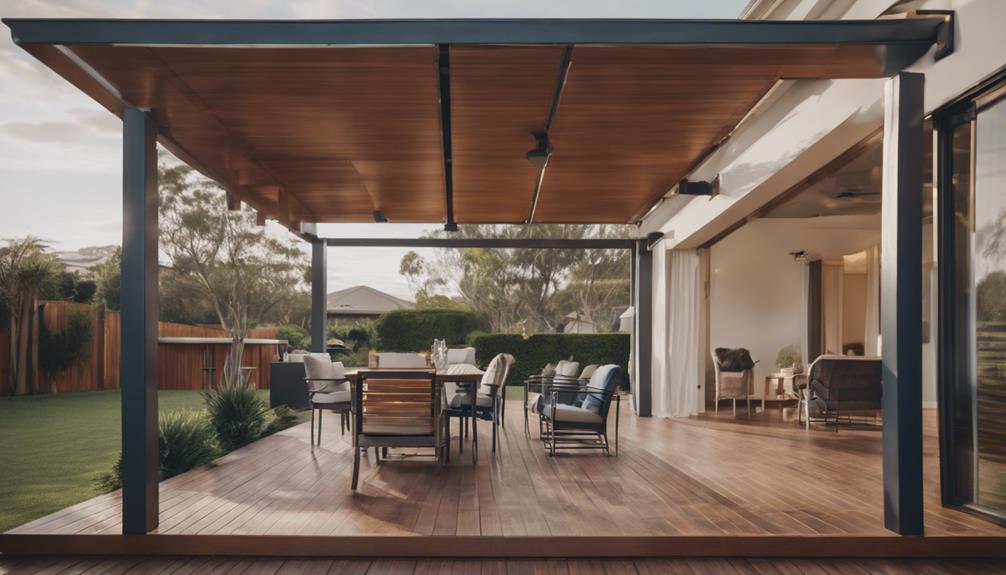
When comparing the structural differences between an alfresco and a verandah, one can observe distinct features that define each outdoor living space. An alfresco is typically an open outdoor space designed for dining and entertaining, often featuring modern elements. In contrast, a verandah is a covered structure attached to the house, usually with a roof and the possibility of being enclosed.
The main difference lies in the construction; alfrescos are more open and contemporary, providing a smooth shift between indoor and outdoor spaces. They're commonly associated with outdoor kitchens and dining areas.
On the other hand, verandahs are more traditional, with a roof overhead offering shelter and often a cozy enclosed feeling. Verandahs can be wraparound or attached to specific parts of the house, offering a variety of design options for outdoor relaxation and socializing.
Both alfrescos and verandahs serve as valuable extensions of the home, providing distinct outdoor living experiences to suit different preferences and needs.
Design Elements of an Alfresco
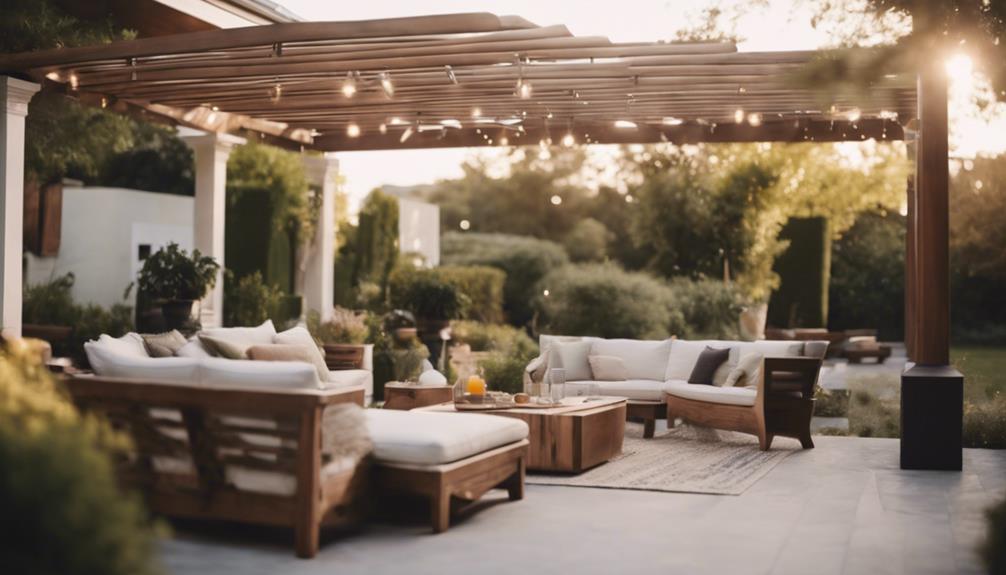
When considering the design elements of an alfresco, it's important to focus on:
- The layout basics
- Furnishing tips
- Lighting
These elements play a vital role in creating a functional and inviting outdoor space for relaxation and entertainment.
Alfresco Layout Basics
In crafting the layout of an alfresco, key design elements such as outdoor kitchens, dining areas, and entertainment spaces play a pivotal role. An alfresco is designed to seamlessly connect the indoor and outdoor living spaces of a home, creating a harmonious flow between the two areas.
The flooring of an alfresco is often made of durable materials like concrete, pavers, or decking to withstand outdoor conditions. Privacy screens, walls, and outdoor furniture are commonly incorporated into alfresco areas to enhance comfort and aesthetics.
One of the main distinguishing features of an alfresco is its integration with the main house structure, allowing for easy access and a unified look. By carefully considering these design elements, an alfresco can be transformed into a functional and inviting outdoor space that complements the overall design of the home.
Alfresco Furnishing Tips
Crafting a well-furnished alfresco involves incorporating weather-resistant furniture, outdoor rugs, lighting fixtures, greenery, and decorative elements to enhance the overall design and comfort of the outdoor space.
When it comes to outdoor dining in your alfresco area, opt for weather-resistant furniture such as wicker or metal to withstand varying weather conditions and guarantee durability. Add outdoor rugs, cushions, and throw pillows to create a cozy atmosphere where you can relax and entertain guests comfortably.
Enhance the ambiance of your alfresco space by installing lighting fixtures like string lights, lanterns, or sconces to provide both functional and aesthetic benefits.
To bring a touch of nature into your alfresco area, consider using greenery like potted plants, hanging baskets, or vertical gardens to create a revitalizing outdoor oasis.
Personalize your alfresco space with decorative elements such as outdoor artwork, sculptures, or wind chimes to reflect your unique style and personality.
Lighting for Alfresco Areas
Lighting plays a pivotal role in setting the mood and functionality of alfresco areas, enhancing both aesthetics and usability.
When it comes to outdoor lighting, there are various options to explore for your alfresco space. Incorporating wall lights can provide ambient lighting, while pendant lights offer a stylish touch.
For a whimsical feel, fairy lights can be draped around the area, creating a cozy atmosphere. Spotlights are ideal for highlighting specific features or areas in your alfresco space.
Opting for LED lights is a practical choice as they're energy-efficient and long-lasting. Dimmable lights add versatility, allowing you to adjust the brightness according to different occasions.
Design Elements of a Verandah
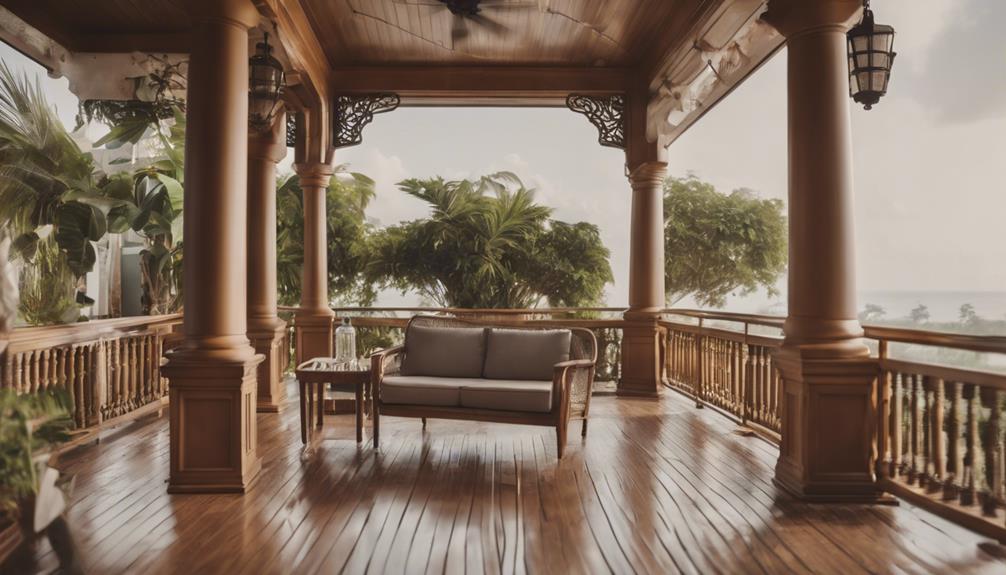
Verandah design basics encompass key elements like columns and balustrades, enhancing both function and style.
Various style options exist, allowing homeowners to tailor their verandah to match the overall aesthetic of their home.
These design choices can create a seamless connection space that blends indoor comfort with outdoor charm.
Verandah Design Basics
When creating a verandah, it's crucial to consider the structure, whether it's open-air or covered, to develop a welcoming outdoor space that seamlessly integrates with the home's architecture.
Verandahs are covered structures that extend from a house, typically elevated and requiring access stairs to reach the platform. These spaces serve as connecting areas between indoor and outdoor spaces, providing a seamless link.
Verandahs are often furnished with seating areas for relaxation and socializing, making them versatile extensions of the home. The design of verandahs can vary, from wraparound styles to open-sided or screened-in options, constructed using a variety of materials.
Verandah Style Options
Incorporating various design elements is key to achieving a visually appealing and functional verandah space. Verandahs offer style options such as flat or gable-style roofs, each providing a distinct look and serving different purposes.
Elements like decorative railing, columns, and balustrades can elevate the charm of a verandah, adding character to the overall design. Whether enclosed with screens for added privacy or left open to create a breezy atmosphere, verandahs offer versatility in their layout.
Classic verandah styles often showcase intricate trim work and detailed woodwork, contributing to a timeless aesthetic. Additionally, verandahs can be customized to harmonize with the architectural style of the home, enhancing its curb appeal.
Alfresco Vs Verandah: Location Variations

As we compare alfrescos and verandahs, one key distinguishing factor lies in their respective locations. An alfresco is typically situated at ground level, seamlessly blending indoor and outdoor spaces. In contrast, a verandah is an elevated structure attached to the main house, often requiring access stairs for entry. Verandahs serve as intermediary areas between the interior and exterior of a home, while alfrescos are directly accessible from the ground level.
The location variation between alfrescos and verandahs impacts their functionality and design. Alfrescos are commonly viewed as extensions of indoor living areas, offering outdoor spaces for dining and entertainment. On the other hand, verandahs provide covered areas for relaxation and social gatherings, adding charm and character to the home's exterior.
While verandahs are integrated into the architectural style of the house, alfrescos offer more versatility in layout and design, catering to different preferences and needs. Both alfrescos and verandahs provide outdoor living spaces, but their distinct locations cater to varying architectural styles and lifestyle choices.
Functionality of Alfresco Spaces
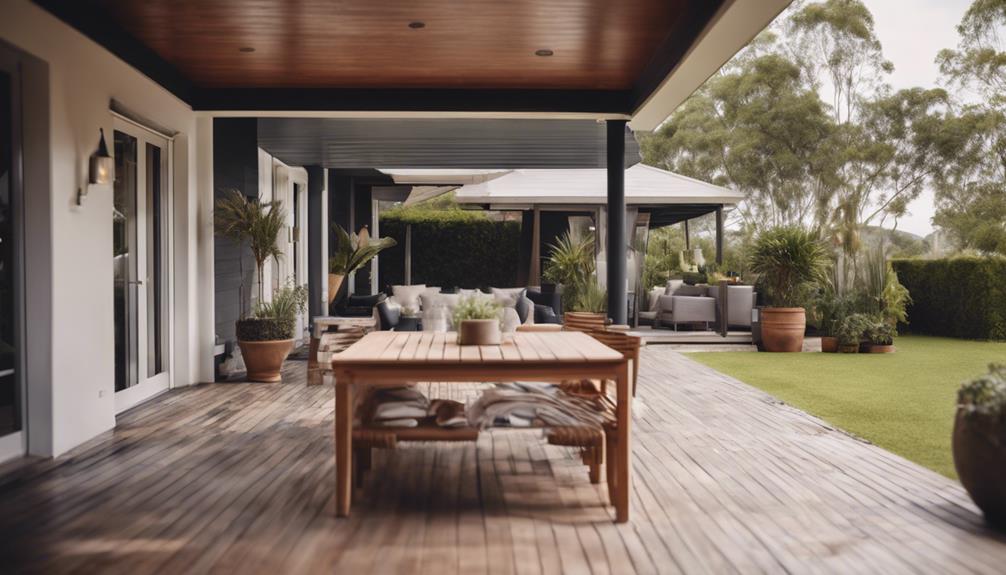
Alfresco spaces are intended for outdoor dining and entertainment, featuring amenities like outdoor kitchens and dining areas.
These areas are designed to seamlessly connect indoor and outdoor living spaces, creating a modern and open-air feel.
The versatility in layout allows for various configurations to suit different preferences and needs.
Alfresco Space Purpose
Designed for outdoor dining and entertaining, alfresco spaces offer a seamless shift between indoor and outdoor living areas. These spaces are specifically crafted to enhance the outdoor experience, providing a perfect setting for casual meals, parties, or family gatherings. Alfrescos commonly feature amenities such as outdoor kitchens, dining areas, and comfortable seating arrangements, making them ideal for socializing and relaxation.
By blurring the lines between indoor and outdoor spaces, alfrescos create a versatile environment that embraces the natural surroundings while offering the comforts of indoor living. The relaxed and inviting atmosphere of alfresco areas makes them popular for enjoying the outdoors in a comfortable setting.
Whether hosting a barbecue with friends or simply unwinding with a good book, alfrescos cater to a variety of activities, making them a valuable extension of the home for both everyday use and special occasions.
Outdoor Living Design
In our outdoor living design, we prioritize creating functional spaces that seamlessly blend indoor comforts with outdoor ambiance. Alfresco spaces are tailored for outdoor dining and entertaining, featuring amenities like outdoor kitchens, dining areas, and cozy furniture arrangements. These areas provide a perfect setting for hosting gatherings and enjoying meals in the fresh air.
Patios are often incorporated into alfrescos, offering additional space for relaxation and socializing.
In contrast, verandahs serve as covered extensions from the house, acting as a connecting zone between the indoor and outdoor areas. They can take on various designs, from wraparound structures to those with open sides or screens, adding character and charm to the home exterior.
While both alfrescos and verandahs contribute to enhancing outdoor living experiences, they've distinct purposes and design elements that cater to different preferences and needs. The functionality and layout of alfresco spaces, especially with the inclusion of outdoor kitchens and dining areas, make them a popular choice for those seeking a seamless indoor-outdoor lifestyle.
Versatility of Layout
When creating alfresco spaces, we prioritize functionality by incorporating versatile layouts that cater to various outdoor dining and entertainment needs. The layout of an alfresco area is carefully planned to optimize the space for dining and socializing, typically including outdoor kitchens, dining areas, and comfortable seating arrangements.
Unlike verandahs, which are more focused on relaxation and in-between spaces, alfrescos are designed to enhance the dining and entertainment experience.
The design possibilities for alfresco layouts are vast, allowing for customization based on individual preferences and requirements. From open-air setups to partially enclosed spaces, alfrescos offer flexibility in design to accommodate different styles and needs.
Functionality of Verandah Spaces
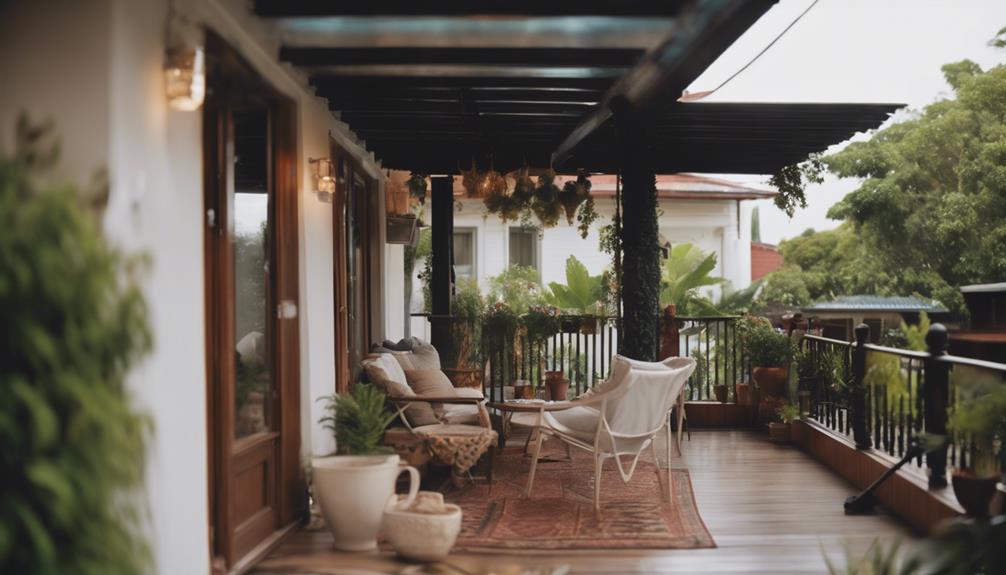
Verandah spaces enhance daily living by seamlessly connecting indoor comfort with outdoor relaxation and social activities. Serving as intermediary areas between the indoors and outdoors, verandahs are covered structures that extend from the main house, adding charm and character to a home's exterior.
These elevated structures often feature open sides or screening, offering a comfortable outdoor space for family and friends to enjoy.
Verandahs are commonly used for relaxing and socializing, providing a perfect setting for gatherings or quiet moments alone. Their design allows for ventilation and natural light while protecting against the elements.
Accessible via stairs, verandahs create a smooth flow between the interior and exterior of a home, encouraging occupants to enjoy the fresh air without sacrificing the comforts of indoor living.
Whether it's sipping morning coffee, reading a book in the afternoon sun, or hosting a casual get-together, verandahs cater to a variety of activities that enrich daily life.
Benefits of an Alfresco Area
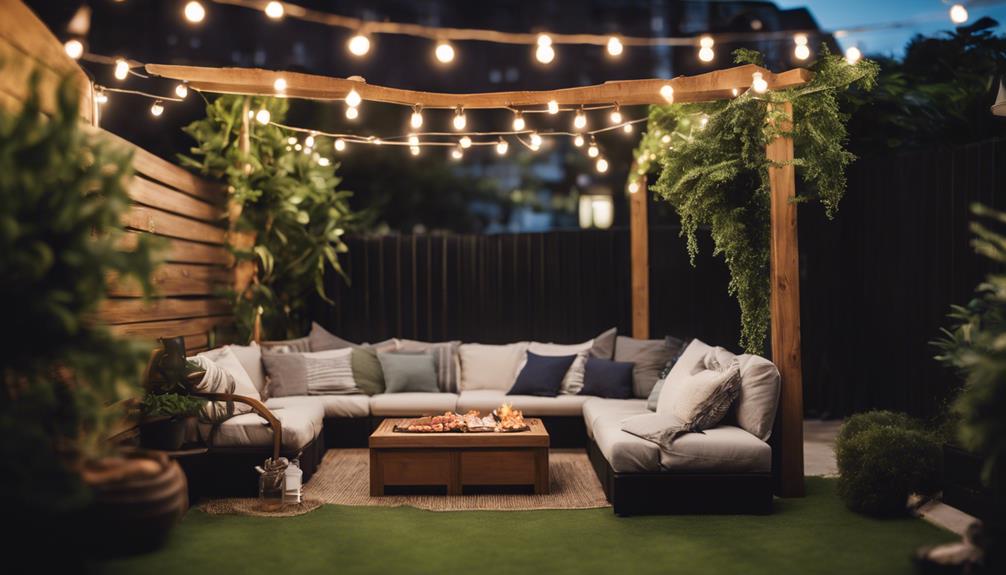
Our alfresco area enhances our outdoor living experience by providing a versatile space for dining and entertaining. It offers protection from the elements, making it suitable for year-round use.
With features like walls, privacy screens, and outdoor furniture, we can enjoy our alfresco area regardless of the weather. This outdoor living space is designed to create a seamless connection to the outdoors, allowing us to relax and socialize in a natural setting.
Additionally, alfrescos can be equipped with outdoor kitchens, dining areas, and other amenities to enhance our outdoor living experience. The feeling of connectedness to the yard or garden further enhances the overall atmosphere, making it an ideal space for gatherings and relaxation.
The customizable nature of alfresco areas allows us to tailor them to match the style and functionality of our home, providing endless design possibilities for our outdoor living space.
Benefits of a Verandah

With their covered outdoor space and architectural enhancement, verandahs provide a functional and stylish extension of the home for enjoying the outdoor environment. These structures are typically located near the front or back door, creating a smooth shift between indoor and outdoor living spaces. Verandahs offer a shaded area where one can relax, socialize, and appreciate the surroundings without being exposed to direct sunlight or harsh weather conditions.
Furthermore, verandahs can be seen as an outdoor extension of the home, similar to how a patio is an outdoor extension of the living room. The elevated design of verandahs not only adds charm to the house's exterior but also provides additional living space for various activities. Whether furnished with cozy seating or used for outdoor dining, verandahs offer a versatile area that can be enjoyed year-round.
Additionally, screened verandahs are particularly beneficial as they keep pesky bugs at bay, allowing for uninterrupted gatherings and leisure time with family and friends. The roof of a verandah provides protection from the elements, making it a valuable asset that combines functionality with aesthetic appeal.
Choosing Between Alfresco and Verandah for Your Home

When deliberating between an alfresco and a verandah for your home, it's important to contemplate the specific functions and aesthetic preferences that align with your outdoor living needs. Both options offer unique benefits and can enhance the overall appeal and functionality of your home.
Here are some factors to keep in mind when choosing between an alfresco and a verandah:
- Purpose: Determine how you plan to use the outdoor space – for dining, entertaining, relaxation, or a combination of activities.
- Home Style: Consider whether your home's architecture leans more towards modern or traditional design to ensure a cohesive look.
- Amenities: Think about the amenities you desire, such as outdoor fireplaces, built-in BBQs, or seating areas, to match your lifestyle.
- Maintenance: Evaluate the upkeep required for each option, as alfrescos and verandahs may have different maintenance needs.
- Property Value: Keep in mind how each choice may impact the overall value of your home, as both patios can add value in different ways.
Frequently Asked Questions
What Is the Difference Between a Veranda and a Covered Porch?
We see a veranda as an elevated, covered structure, longer and tied to the home, creating a charming intermediate space. Covered porches, simpler and at ground level, are cost-effective options for outdoor relaxation areas.
Is a Patio the Same as a Verandah?
When comparing a patio and a verandah, we notice distinctions. A patio is ground-level, while a verandah is raised and attached to a house. Both offer outdoor space but differ in elevation, structure, and cost.
What Is an Alfresco on a House?
An alfresco on a house is an outdoor living area attached to the main structure, offering extended space for dining, entertaining, and relaxation. It allows us to enjoy nature while still being connected to the indoors.
What Is a Covered Front Porch Called?
A covered front porch, commonly known as a verandah, provides a charming outdoor space. With its roof, columns, and railings, it offers a welcoming entrance. We love relaxing and socializing on our verandah, enjoying the fresh air.
What Makes a Veranda a Veranda?
We believe a veranda is distinguished by its covered structure extending from the main house, often elevated with access stairs. It serves as a connecting area between indoors and outdoors, providing a cozy space for relaxation and socializing.
Conclusion
To sum up, the distinctions between an alfresco and a verandah are evident when considering structure, design elements, location variations, and functionality.
Both provide unique advantages for homeowners seeking to enhance their outdoor living space.
When deciding between the two, take into account your specific needs and preferences to make the best choice for your home.
Stay tuned for more tips and insights on creating the perfect outdoor space for your lifestyle.
- About the Author
- Latest Posts
Introducing Ron, the home decor aficionado at ByRetreat, whose passion for creating beautiful and inviting spaces is at the heart of his work. With his deep knowledge of home decor and his innate sense of style, Ron brings a wealth of expertise and a keen eye for detail to the ByRetreat team.
Ron’s love for home decor goes beyond aesthetics; he understands that our surroundings play a significant role in our overall well-being and productivity. With this in mind, Ron is dedicated to transforming remote workspaces into havens of comfort, functionality, and beauty.
-

 Vetted2 weeks ago
Vetted2 weeks ago15 Best Leather Restorer Products to Revive Your Furniture and Accessories
-

 Vetted2 weeks ago
Vetted2 weeks ago15 Best Contact Paper for Kitchen Cabinets to Elevate Your Home Decor
-

 Vetted3 weeks ago
Vetted3 weeks ago15 Best Leg Massagers to Relieve Tension and Improve Circulation – Ultimate Guide
-

 Vetted4 weeks ago
Vetted4 weeks ago14 Best Lawn Tractors of 2024 – Ultimate Guide for Your Yard Maintenance
-

 Vetted1 week ago
Vetted1 week ago15 Best Drain Snakes to Unclog Your Pipes Like a Pro
-

 Vetted4 weeks ago
Vetted4 weeks ago15 Best Commercial Backpack Vacuums for Efficient Cleaning Tasks
-

 Vetted3 weeks ago
Vetted3 weeks ago15 Best Lawn Games for Adults to Elevate Your Outdoor Gatherings
-

 Vetted4 weeks ago
Vetted4 weeks ago15 Best Group Games for Adults to Spice Up Your Next Gathering

















